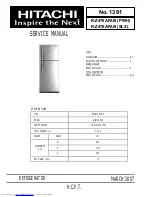
30
IMPORTANT:
Refrigerator shelves with under-shelf, LED lighting
are not dishwasher safe.
1.
Unplug refrigerator or disconnect power.
2.
Hand wash, rinse, and dry removable parts and interior
surfaces thoroughly. Use a clean sponge or soft cloth and a
mild detergent in warm water.
NOTE:
Do not use abrasive or harsh cleaners such as window
sprays, scouring cleansers, flammable fluids, cleaning waxes,
concentrated detergents, bleaches, or cleansers containing
petroleum products on plastic parts, interior and door liners,
or gaskets.
3.
Plug in refrigerator or reconnect power.
Condenser Cleaning
There is no need for routine condenser cleaning in normal
home operating environments. If the environment is particularly
greasy or dusty or there is significant pet traffic in the home,
the condenser should be cleaned every 6 months to ensure
maximum efficiency.
If you need to clean the condenser, please call for service.
Lights
The lights in both the refrigerator and freezer compartments
are LEDs which do not need to be replaced. If the lights do not
illuminate when the door or drawer is opened, call for assistance
or service. In the U.S.A., call
1-800-253-1301
. In Canada, call
1-800-807-6777
.
Vacation and Moving Care
Vacations
If You Choose to Leave the Refrigerator On While You’re
Away:
1.
Use up any perishables and freeze other items.
2.
If your refrigerator has an automatic ice maker and is
connected to the household water supply, turn off the water
supply to the refrigerator. Property damage can occur if the
water supply is not turned off.
3.
If you have an automatic ice maker, turn off the ice maker.
■
Press the switch to OFF for the door ice maker.
4.
Empty the ice bin.
If You Choose to Turn Off the Refrigerator Before You Leave:
NOTE:
Put refrigerator in Showroom Mode while on Vacation.
See “Using the Controls” section.
1.
Remove all food from the refrigerator.
2.
If your refrigerator has an automatic ice maker:
■
Turn off the water supply to the ice maker at least 1 day
ahead of time.
■
When the last load of ice drops, press the switch to OFF
for display to be unlit on the top inside of the refrigerator,
depending on your model.
3.
Empty the ice bin.
4.
Turn off the temperature controls. See “Using the Controls”
section.
5.
Clean refrigerator, wipe it, and dry well.
6.
Tape rubber or wood blocks to the tops of both doors to prop
them open far enough for air to get in. This stops odor and
mold from building up.
Moving
When you are moving your refrigerator to a new home, follow
these steps to prepare it for the move.
1.
If your refrigerator has an automatic ice maker:
■
Turn off the water supply to the ice maker at least 1 day
ahead of time.
■
Disconnect the water line from the back of the refrigerator.
■
When the last load of ice drops, press the switch to OFF
either on the ice maker or the control, depending on your
model.
2.
Remove all food from the refrigerator and pack all frozen food
in dry ice.
3.
Empty the ice bin.
4.
Unplug refrigerator.
5.
Clean, wipe, and dry thoroughly.
6.
Take out all removable parts, wrap them well, and tape them
together so they don’t shift and rattle during the move.
7.
Depending on the model, raise the front of the refrigerator
so it rolls more easily OR raise the leveling screws so they
don’t scrape the floor. See “Adjust the Doors” or “Refrigerator
Leveling and Door Closing” section.
8.
Tape the doors closed and tape the power cord to the back of
the refrigerator.
When you get to your new home, put everything back and refer to
the “Installation Instructions” section for preparation instructions.
Also, if your refrigerator has an automatic ice maker, remember to
reconnect the water supply to the refrigerator.









































